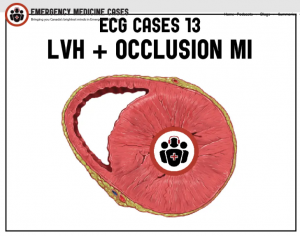In this post I link to and excerpt from Emergency Medicine Cases‘ ECG Cases 13: LVH and Occlusion MI. Written by Jesse McLaren; Peer Reviewed and edited by Anton Helman. September 2020.
All that follows is from the above post:
In this ECG Cases blog we look at 6 patients who presented with potentially ischemic symptoms and LVH on their ECG. Which had an acute coronary occlusion?
LVH and occlusion MI
Hypertrophy of the left ventricle produces higher voltages towards the left-sided leads (taller R wave in I, AVL, V5-6) and away from the right-sided leads (deeper S wave in V1-2). There have been dozens of voltage criteria developed for LVH [1], and ECG expert Dr. Grauer has summarized and simplified them in this visual on Dr. Smith’s blog:
The abnormal depolarization in LVH produces secondary and discordant repolarization abnormalities which can mimic STEMI: anterior convex ST elevation can mimic anterior STEMI, ST depression and T wave inversion in aVL can mimic reciprocal changes in inferior MI, and diffuse ST depression with reciprocal elevation in aVR can mimic this so-called “STEMI-equivalent” pattern. Severe LVH can prolong QRS beyond 120ms and mimic LBBB, which has led to a new definition of LBBB including “QRS duration ≥140 ms for men and ≥130 ms for women, and also mid-QRS notching or slurring in at least 2 of the leads I, aVL, V1, V2, V5 or V6.”[2]
Patients with LVH presenting to the ED with ACS symptoms are older, have more comorbidities, present with more atypical complaints, are more likely to have CHF and have a higher mortality rate [3]. But LVH is also the greatest predictor of false-positive STEMI activation [4]. STEMI guidelines (and the STEMI/NSTEMI dichotomy) don’t help, because both American and European guidelines define STEMI as ST elevation “in the absence of LVH”. So what about those with LVH? As a review explained,
“Neither document defines thresholds for STE in patients with LVH. In addition, there is confusion whether the exclusion of STE thresholds in patients with LVH is limited to leads V2-3 or applies to all leads…Thus, with the lack of specific instructions, it is unclear when exactly a primary percutaneous coronary intervention (pPCI) protocol should be activated for patients with LVH presenting with symptoms compatible with ACS…Comparison to previous ECGs and serial ECGs, looking for dynamic changes may assist in the diagnosis. However, marked fluctuation in the amplitude of ST deviation can be seen over time in patients without active ischemia. The absolute amplitude of ST deviation depends on the amplitude of the QRS complex (edema, effusion and acute pulmonary conditions may decrease the QRS amplitude), QRS width, heart rate, etc. Also, lead positioning and even the position of the patient (supine versus sitting) may have major effects on the ST amplitude.”[5]
Drawing on principles of proportionately (which can help diagnose occlusion MI in the presence of LBBB or LV aneurysm), Armstrong proposed an algorithm to identify anterior STEMI in the presence of LVH: “In patients with STE in leads V1 to V3, an ST segment to R-S–wave magnitude 25% excluded the diagnosis of a STEMI. If the ST segment to R-S–wave magnitude was 25%, presence of STE in 3 contiguous leads or presence of T-wave inversions in the anterior leads classified patients as having a ‘true’ STEMI.” This was based on 79 cath lab activations for patients with LVH (22 with culprit lesions) and had a sensitivity of 77% and specificity of 91% (vs sensitivity of 73% and specificity of 58% for STEMI criteria) [6]. But as a review of new ECG insights into acute coronary occlusion explained, “the study did not assess ECGs with very high right precordial S-wave voltages, which are precisely the ECGs that are difficult. Any ST/S ratio > 15% in the setting of high S-wave voltage in V1-V3 is suspicious for new anterior STE: 15% of a 30-mm S wave is 4.5 mm, whereas a 25% rule would require 7.5 mm of STE.” [7]
Now, reviewing the six ECGs Dr. McLaren has given us:
Case 1: 75yo with two hours of chest pain, AVSS.
Case 1. HOCM with secondary ST/T changes
- Heart rate/rhythm: NSR
- Electrical conduction: normal intervals
- Axis: normal axis
- R-wave: large voltage, normal progression
- Tension: LVH (Sv1+Rv5>35 + strain; in addition, RaVF>20; Rv5>25)
- ST/T: diffuse T wave inversion discordant and proportional to large voltages
Impression: LVH with secondary ST/T wave changes.
Cath lab was activated because there is diffuse ST depression with reciprocal ST elevation in aVR, but these ST/T wave changes are secondary to LVH). Serial ECGs were unchanged, trops were negative, and echo showed HOCM.






